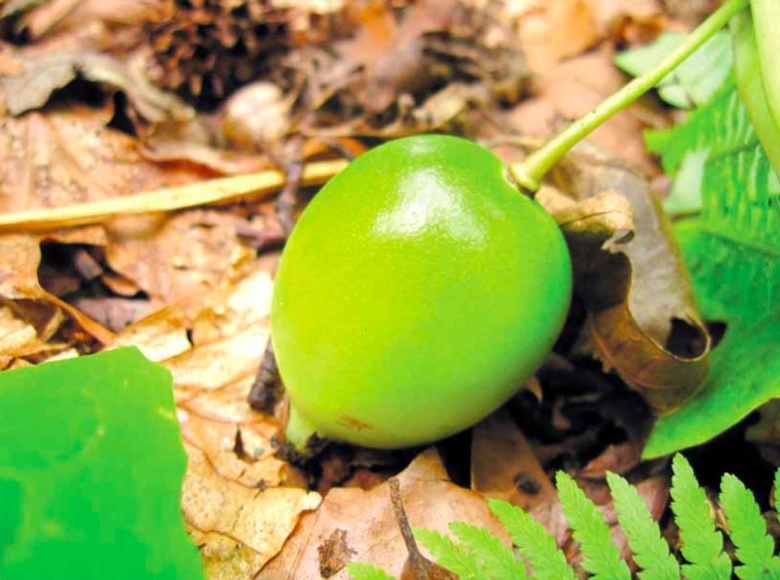When it comes to urban foraging, I am a repeat offender. Literally: Picking plants from city parks remains a ticketable offense. But that’s not the only reason I’ll tread lightly in the May apple patch in Central Park’s Ramble in late July.
A native perennial whose flowers bloom in May, Podophyllum peltatum bears an egg-shaped fruit whose palatable common name is “May apple”; the fruit is also commonly called “American mandrake.” Pause for thought—mandrake (genus Mandragora) is poisonous.
But these American exotica with a similar name remained high on my “to eat” list after reading Euell Gibbons’ Stalking the Wild Asparagus. “When I eat a thoroughly ripe May apple, I am reminded of several tropical fruits—the guava, the passion fruit and the soursop—but I can’t honestly say that it tastes like any of them.”
I had kept close watch on a stand of the plants since early in the year. I knew that they had to be overripe or they would still be toxic. I knew that the roots are poisonous. So are the leaves of rhubarb, green potatoes, apricot kernels, English ivy, amelanchier leaves—we are surrounded by death in plant form.
I intended to eat the ripe, scented fruit with impunity.
By the end of June the foliage was beginning to be spotty, and the leaves were thinking about collapsing, all good signs. Summer dormancy was almost upon them, when the green fruit would lie on the ground, still attached to its umbilical stem, and ripen.
Early July and a promising yellow had overtaken the pale green. But the fruit was still solidly hard. I waited.
At last the day came when I spied on its leaf litter the egglike shapes whose mottled edges promised the degree of ripeness I’d been waiting for. I picked two, put them in my bag and promptly forgot about them. One night while my husband was at work, I smelled a heavenly, tropical scent. Perfect timing. My mate does not approve of my promiscuous grazing habits, so I chose the route of non-confrontation: Eat it while he’s out.
In Identifying and Harvesting Edible and Medicinal Plants, infamous urban forager Steve Brill had advised, “Enjoy when ripe.” So I did.
It smelled of passion fruit and a little like pineapple. A hint of overripe guava. The peel came off easily, the aroma increased. My mouth watered. The jellylike pulp and the seeds were inseparable. For a split second I paused at the seeds— but reasoned that they would just go straight through me.
Two bites, and down it all went. It was complex, slightly astringent and utterly delicious.
Savoring the flavor, I thought back with satisfaction on the homework I had done.
Then it hit me with horror. Seeds. Nobody mentions seeds. So I went to the web, where I read that the seeds are toxic, poisonous, rumored to be deadly. At 10 p.m. I called Mr. Brill, who told me to call a doctor: “No one eats the seeds,” he said.
What about your airy advice, “Enjoy it raw and cooked”? I guess the book should be taken with a grain of salt.
I hung up.
The May apple was much more pleasant going down than coming up but I bore it no ill will. Mr. Brill’s words on the phone were still ringing in my ears. And I could not imagine my husband’s wrath if he’d found me in fetal position after eating yet another strange thing that grew in the bushes.
My foraging friend Ellen Zachos sent me a jar of her May apple jelly as compensation. It was clear, quivering suggestively and throwing off refracted light from its delicately yellow contents. It stayed down.
I don’t do drugs. But I do fruit. And this July, after more reading and more conversations with foragers who have lived to tell their May apple tale, I will do them again.



